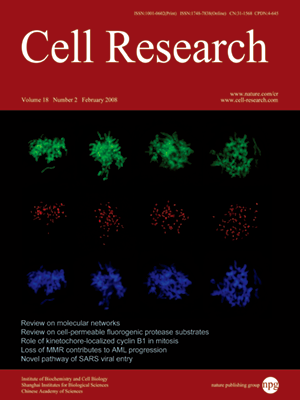
Volume 18, No 2, Feb 2008
ISSN: 1001-0602
EISSN: 1748-7838 2018
impact factor 17.848*
(Clarivate Analytics, 2019)
Volume 18 Issue 2, February 2008: 290-301
ORIGINAL ARTICLES
SARS coronavirus entry into host cells through a novel clathrin- and caveolae-independent endocytic pathway
Hongliang Wang1, Peng Yang1, Kangtai Liu1, Feng Guo1, Yanli Zhang1, Gongyi Zhang2 and Chengyu Jiang1
1National Key Laboratory of Medical Molecular Biology, Institute of Basic Medical Sciences, Peking Union Medical College, Tsinghua University and Chinese Academy of Medical Sciences, Beijing 100005, China
2Department of Immunology, National Jewish Medical and Research Center, Denver, CO 80206, USA
Correspondence: Chengyu Jiang(jiang@pumc.edu.cn )
While severe acute respiratory syndrome coronavirus (SARS-CoV) was initially thought to enter cells through direct fusion with the plasma membrane, more recent evidence suggests that virus entry may also involve endocytosis. We have found that SARS-CoV enters cells via pH- and receptor-dependent endocytosis. Treatment of cells with either SARS-CoV spike protein or spike-bearing pseudoviruses resulted in the translocation of angiotensin-converting enzyme 2 (ACE2), the functional receptor of SARS-CoV, from the cell surface to endosomes. In addition, the spike-bearing pseudoviruses and early endosome antigen 1 were found to colocalize in endosomes. Further analyses using specific endocytic pathway inhibitors and dominant-negative Eps15 as well as caveolin-1 colocalization study suggested that virus entry was mediated by a clathrin- and caveolae-independent mechanism. Moreover, cholesterol- and sphingolipid-rich lipid raft microdomains in the plasma membrane, which have been shown to act as platforms for many physiological signaling pathways, were shown to be involved in virus entry. Endocytic entry of SARS-CoV may expand the cellular range of SARS-CoV infection, and our findings here contribute to the understanding of SARS-CoV pathogenesis, providing new information for anti-viral drug research.
Cell Research (2008) 18:290-301. doi: 10.1038/cr.2008.15; published online 29 January 2008
FULL TEXT | PDF
Browse 1982


